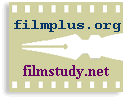[ montage pages : film.vtheatre.net/montage ]
EDITING is a dramatic thought-feeling flow!
How-to take notes during the viewing and the right questions to ask:
Deconstruction -- break down the story into main segments. Exposition, Climax, Resolution. Each has to be segmented into scenes and episodes. List them. Look for structure! Check my Aristotle's Page, if you do not understand the difference between structure and texture law. Write down what you like and what you don't. Return to it asking "why" -- what are the elements of film which work or not in place? Ask "how" the effect is done.
Questions for "paper film-making":
LINES OF INQUIRY
[ drama analysis ]
Dramatic Structure
[ recent titles -- Into the Wild, 2007 ]
Composition, Story, Characters, Ideas
1. What is the film (really) about (Idea, Message, Thought)?
2. What are the major (social) issues in the film (Themes)?
3. Did the film feel the right length or was it too long (Form and Meaning)? (Storytelling has problems?)
4. Were there any parts that were unclear or puzzling? (Itemize
those you suspect. Dramatic analysis of composition in details).
5. Which parts felt slow (Composition: begining, middle, end -- compare plot and story)?
6. Which parts were moving or otherwise successful and why?
7. What did you feel about _______________ (name of character)?
Conflict, inner conflict, moral choices, etc.
8. What did you end up knowing about ________ (situation or issue)?
CINEMATOGRAPHY (CAMERA WORK)
ASSESSING EDITING
1. Do action match cuts flow smoothly?
2. Is screen direction maintained?
3. Have the locale is revealed to a first-time viewer?
4. Is the environment fully utilized by the characters and thus
made active in the drama?
5. Is it apparent on-screen when a character changes body position?
6. Are convincing dialogue rhythms maintained, even when a cut
takes place in the middle of a sentence?
7. Have you full exploited eye-line shifts?
8. Have you fully expanded moments of significant action and
charged silences?
9. Do changes of scene rhythm occur convincingly with changes in
characters' perceptions, thought patterns, and actions?
10. Does the scene breathe (either moving us close or distancing
us where psychologically necessary, switching us between
subjective and objective camera positions for variety?)
11. Does the way you have shot and cut the material convey a
point of view (that is, effectively reveal the state of mind of
the main character)?
12. Are there any redundancies (of dialogue, action, angle, etc.)?
13. What does the scene imply about back-story and what might
come after?
1. USE OF CAMERA
1. Does the camera follow the movement of a character?
2. Does it lay out a landscape or a scene geography for the
audience?
3. Does the camera move away from someone or something so we see
more objectively?
4. Does the camera reveal significant information by moving?
5. Is the move really a reframing to accommodate a rearrangement
of characters?
6. Is the move a reaction (panning to a new speaker, for
instance)?
7. When do we directly experience a character's POV?
8. What is the dramatic justification? To accommodate subject
matter? To make you see a certain way?
2. USE OF SOUND
1. Complimenting camera position?
2. Counterpointing camera perspective?
3. Uniformly intimate (voice-over, for instance)?
4. To build atmosphere and mood?
5. As punctuation?
6. To motivate a cut? (next sequence's sound rises until we cut
to it)
7. As a narrative devise? (dramatic sound)
8. To build, sustain, or defuse tension?
9. To provide rhythm?
10. To create uncertainty?
3. CUTS (What motivates each cut?)
1. Is there an action match to carry the cut?
2. Is there a compositional relationship between the two shots
that makes the cut interesting and worthwhile?
3. Is there a movement relationship that carries the cut?
4. Does someone leave the frame (making us want to see a new
frame)?
5. Does someone/something fill the frame, blanking it out and
permitting a cut to another frame that starts blanked and then
clears?
6. Does someone or something enter the frame and demand closer
attention?
7. Are we cutting to follow someone's eye-line, to see what they
see?
8. Is there a sound, or a line, that demands that we see the
source?
9. Are we cutting to show the effect upon a listener and what
defines the moment to cut?
10. Are we cutting to a speaker at a particular moment that is
visually revealing? What defines that moment?
11. If the cut intensifies our attention, what justifies that?
12. If the cut relaxes and objectifies our attention, what
justifies that?
13. Is the cut to a parallel activity (that is, something going
on simultaneously)?
14. Is there some sort of comparison or irony being set up
through juxtaposition?
15. Are we cutting to a rhythm?
What is the relation of sounds to images?
1. Does it help identify the new image?
2. Does it give it a particular emphasis or interpretation?
3. Is the effect expected or unexpected?
4. Is there a deliberate contradiction?
Where and how is music used?
1. How is it initiated? (characters or story begin some kind of
motion, action, emotion).
2. What does the music suggest by its texture, instrumentation, etc.?
3. How is it finished? (characters/story arrive at new location, the change)
4. What comment is it making? (ironic, sympathetic, lyrical, POV)
30 sec. Commercials Assignment
Print the questions and try to answer, using the commercial you selected. View it again. See you in class
Back to Film Directing 101 -- Editing *

 * filmplus.org/kino * picasaweb.google.com/anatoly.antohin * my shared page google
* diggo [ new ] & 2010 AA Ethiopia
* filmplus.org/kino * picasaweb.google.com/anatoly.antohin * my shared page google
* diggo [ new ] & 2010 AA Ethiopia


 theatre theory and
theatre theory and  blog: anatoly-film
blog: anatoly-film















